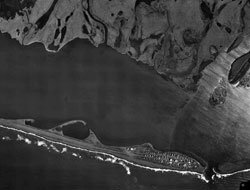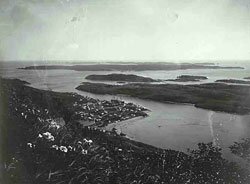
 |
|
||||||||||||||||||||||||
|
The Geography of Alaska
Thinking Geographically
In a word, geography is the study of Where. Geographers study the spatial aspects of physical and human features on the earths surface. The roots of the word geography come from two Greek words meaning earth (geo) and describe (graphia) or the description of the earth. Geography also involves analyzing why things are distributed the way they are such as the location of forest lands in Alaska. Geography also studies how different features are related and the significance of those spatial relationships. An example of this type of study might focus on the comparative distribution of known mineral deposits and Alaska National Interest Lands (Figure G.1).
Description Geographers use a number of ways to describe how things are distributed on the earths surface: writing, maps and graphs, and images. All are important and give different perspectives. Whether it is a novelist setting the backdrop for a story or an explorer describing a new area, good written geographical description is necessary. Words convey images of scenes and activate our minds. Mystery writers often use detailed geographic descriptions of a geographic region to set the stage for their tale. Tony Hillerman has given evocative descriptions of the Navaho lands in his mystery stories. Similarly, Dana Stabenow and John Straley have provided geographic descriptions of Alaska in their mystery stories. Carefully written geographic and related scientific reports have been of great importance in exploration. In 1899, the Harriman Alaska Expedition traveled through coastal Alaska. The scientific reports of the expedition were contained in twelve volumes. Maps give us a direct visual indication of how features are distributed. For example, the bear species Ursus arctos includes both brown bears and polar bears. The species is found throughout much of Alaska. However, a quick look at Figure G.2 shows that the distribution of the species is uneven. The highest densities are found in and near coastal areas bordering the Pacific Ocean. A closer look shows that the density drops dramatically in portions of Southeastern Alaska where Ursus arctos is not found at all south of Frederic Sound. This simple map says a lot about the distribution of the bear species. If you would like to test this out, try writing a more full description of the bears distribution than the brief synopsis given above. Today Geographers and other specialists interested in the where of things use a variety of spatial tools. The cartographers map is now commonly constructed using a computer and digital data or Geography Information SystemsGIS. A vast amount of information, perhaps, 80% of all data collected, has a geographic component and can help us in our understanding and use of that information. Consider, for instance, the land ownership records of Alaska. The data is categorized by subunits of townships which were originally devised to simplify land acquisition as American settlement moved westward from the Appalachian Mountains. Figure G.3 shows the statewide pattern of ownership distribution. However, it does not show details for any particular area. With a GIS constructed map, these details are averaged out mathematically. A more detailed map of a specific area, in contrast, shows that the ownership patterns in some areas are actually fairly complex. Further, an even more detailed map would show small holdings by private land owners. Figure G.4 Aerial photograph of Kivalina, 1999. Collection Name: Alaska Department of Community and Economic Development Cameras and art also provide us with excellent views of a landscape. The Harriman Alaska Expedition of 1899 included artists, poets, and a photographer. Their images of Alaska at the time have proven very valuable for an understanding of the changes in the physical and human environments over the last century. (See Figure G.5, an image from the original expedition.) Analysis In our desire to understand things, we often use inductive reasoning. We gather a lot of information on a subject and then reach a conclusion which can then be tested for application in other situations.  Figure G.5 Photograph of Kodiak from the Harriman Alaska Expedition Collection Name: The Harriman Alaska Expedition: Chronicles and Souvenirs May to August 1899
|
||||||||||||||||
|